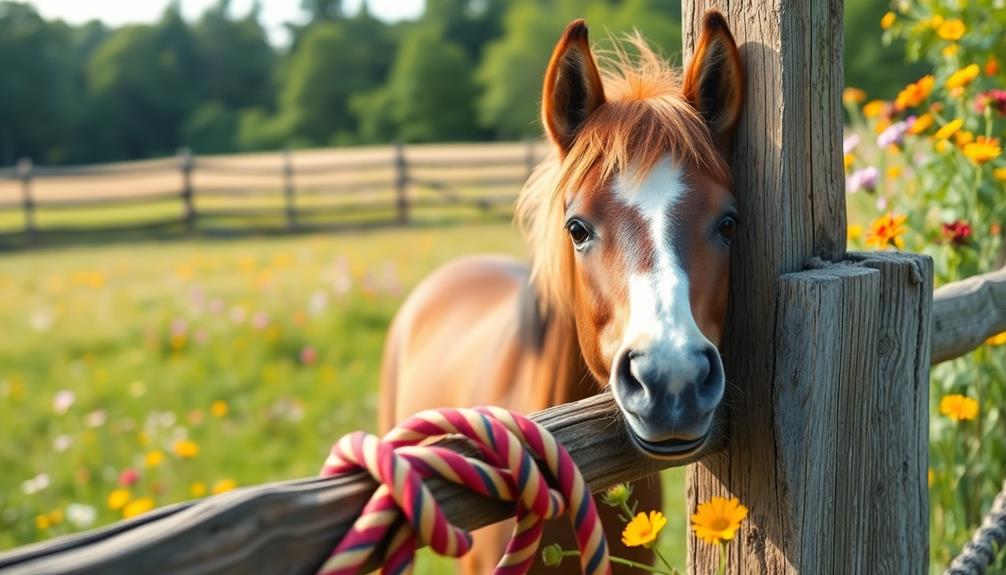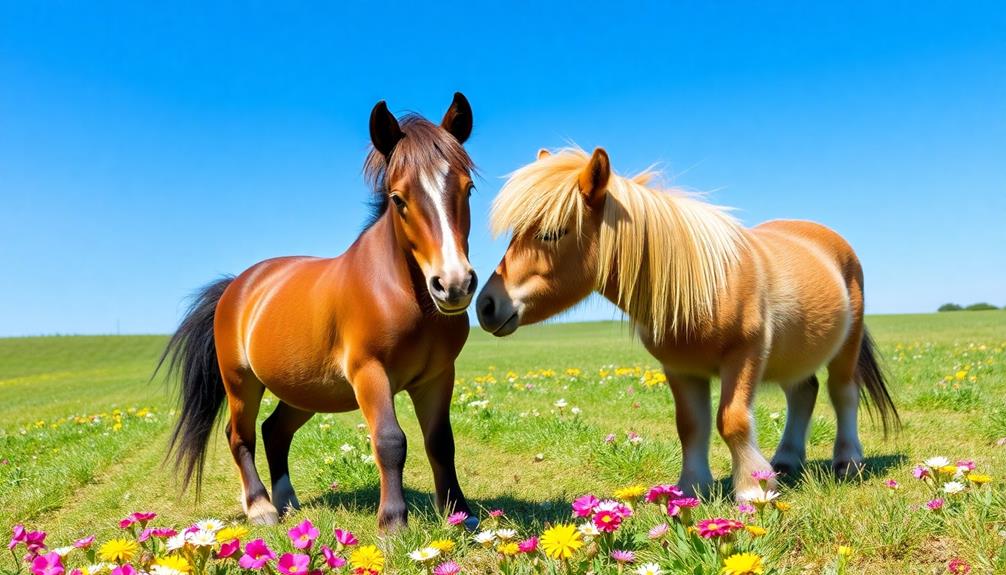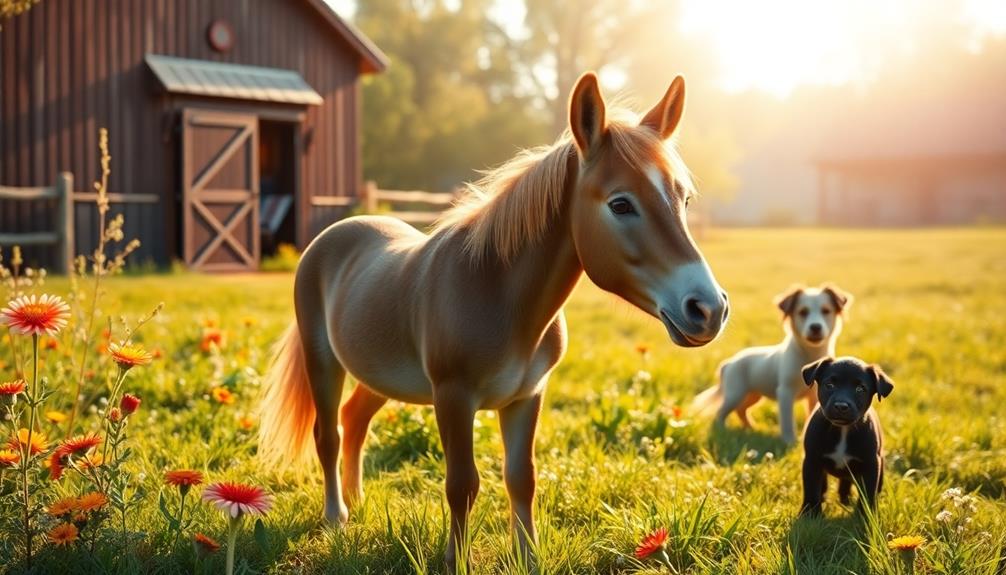A miniature horse driving whip is an essential tool for enhancing your control and communication with your mini. The whip should be appropriately sized, ideally not exceeding your horse's shoulder height. Look for lightweight options like the MCR Ultra Lite or Dobert Whips for better handling. You'll appreciate how the right grip improves your comfort during drives. Regular practice with your whip builds muscle memory, making your commands more intuitive. This gear not only elevates your performance but also guarantees safety. Explore more details to find the perfect whip that fits both you and your miniature horse's needs!
Key Takeaways
- The whip length should not exceed the shoulder height of your Class A Miniature Horse for safe handling.
- Lightweight materials like e-glass improve balance and reduce strain while driving.
- Customizable options for grip size and lash length enhance comfort and control during use.
- Top brands like MCR Ultra Lite and Dobert provide quality and user-friendly designs.
- Regular practice with the whip builds muscle memory, improving overall driving technique.
Understanding Whip Length and Type
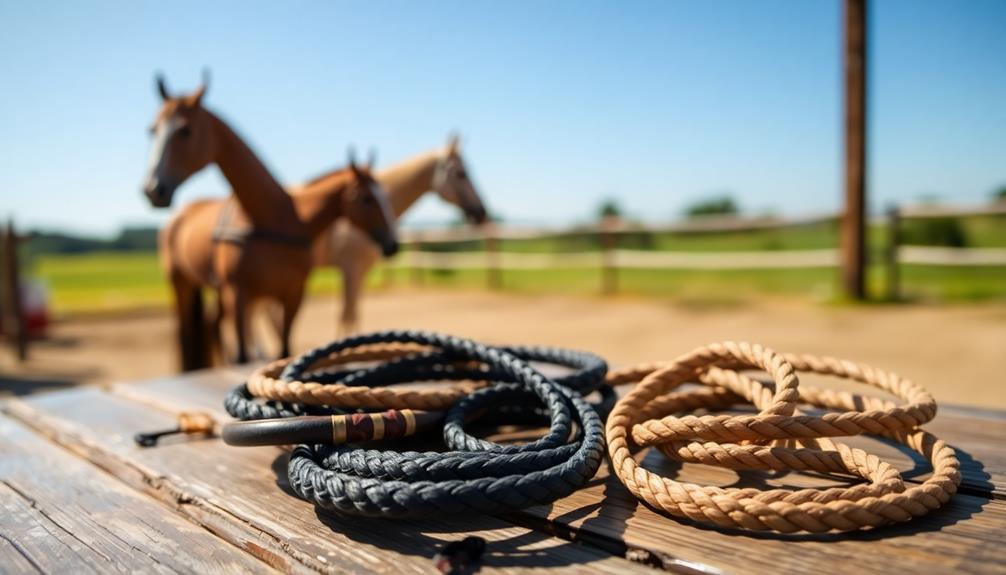
When it comes to understanding whip length and type for driving Miniature Horses, you'll want to focus on a few key factors that guarantee safety and effective communication.
The ideal driving whip length for Class A Miniature Horses should make sure the lash tip doesn't exceed the horse's shoulder. This height keeps interactions safe and allows for clear signals.
Opt for a longer whip shaft paired with a short lash to enhance control and precision during driving. A customized dressage whip can also work well if it features a short lash of around 4 inches, providing improved handling and light contact.
You should also consider the balance and weight distribution of the whip. Lighter materials, like e-glass, are preferable over brittle options such as graphite. This choice guarantees that the whip is easy to maneuver while maintaining durability.
Lastly, remember to check breed show regulations for whip length specifications, as they can vary between organizations like AMHA and AMHR.
Keeping these factors in mind will help you select the right driving whip for effective communication with your Miniature Horse.
Top Whip Brands for Miniatures

When you're choosing a whip for your miniature horse, you'll find plenty of lightweight options that won't weigh you down.
Brands like MCR Ultra Lite and Dobert offer great designs, while companies like Iowa Valley Carriage let you customize your whip to fit your unique driving style.
If you're on a budget, Fleck nylon whips provide excellent quality at an affordable price, making them a popular choice for drivers at any experience level.
Lightweight Options Available
Finding the right lightweight driving whip for your miniature horse can greatly enhance your driving experience. Lightweight options are essential for comfort and control, and several brands offer excellent choices.
Here's a quick comparison of some top lightweight whips:
| Brand | Features |
|---|---|
| MCR Ultra Lite | Balanced and easy to handle |
| Fleck Nylon | Affordable, priced under $30 |
| Dobert | Slim grip, weighs only 3 oz |
| UltraLite | Durable graphite, lightweight yet sturdy |
| Driving Essentials | Variety tailored for smaller breeds |
| Iowa Valley Carriage | Designed for specific driving needs |
MCR Ultra Lite whips are well-regarded for their balance, making them a joy to use. If you're on a budget, Fleck nylon whips offer affordability without sacrificing quality. Dobert whips are perfect for those with smaller hands, while UltraLite whips provide durability. Both Driving Essentials and Iowa Valley Carriage focus on mini whips, ensuring a good fit for you and your horse. With these lightweight options, you'll be well-equipped to enjoy your driving adventures!
Customization for Specific Needs
Lightweight driving whips can greatly improve your miniature horse driving experience, but customization takes it to the next level. When you opt for a custom-made whip, you can tailor it specifically to your needs. Different lengths, lash configurations, and grip sizes can make all the difference, ensuring your whip feels just right in your hands.
Brands like MCR, Fleck, and Dobert offer popular options that cater to miniature horses and their drivers. The MCR Ultra Lite whips are particularly sought after for their lightweight design and balance, allowing for an excellent driving experience while accommodating personalized features.
You can choose grip tape for better comfort or specialized lash lengths for improved handling during different driving scenarios. Understanding your unique measurements is essential when customizing a whip. Knowing the distance from your saddle to the desired lash length will help you achieve peak performance.
With a custom-made whip, you gain not only comfort but also enhanced control, making each driving session more enjoyable and effective. Investing in a whip tailored to your specifications elevates your driving game and strengthens your bond with your miniature horse.
Popular Affordable Choices
If you're searching for affordable and effective options for miniature horse driving whips, several brands stand out in the market. Here's a quick overview of some popular choices that combine quality and affordability:
| Brand | Features | Price Range |
|---|---|---|
| MCR Ultra Lite | Lightweight and balanced design | $25 – $35 |
| Ideal Fleck | Quality nylon, under $30 | Typically under $30 |
| Driving Essentials | Tailored for smaller breeds | $20 – $30 |
| Iowa Valley Carriage | Customizable options | $30 – $50 |
| Dobert | Slim grip, only 3 ounces | $20 – $40 |
Each of these driving whip brands offers something unique for your miniature horse driving needs. The MCR Ultra Lite whips are praised for their balance, while Ideal Fleck provides excellent quality at an affordable price. If you prefer customized whips, Iowa Valley Carriage has you covered. For those with smaller hands or arthritis, Dobert whips are lightweight and easy to handle. Choosing the right driving whip can enhance your experience and communication with your mini!
User Experiences and Feedback
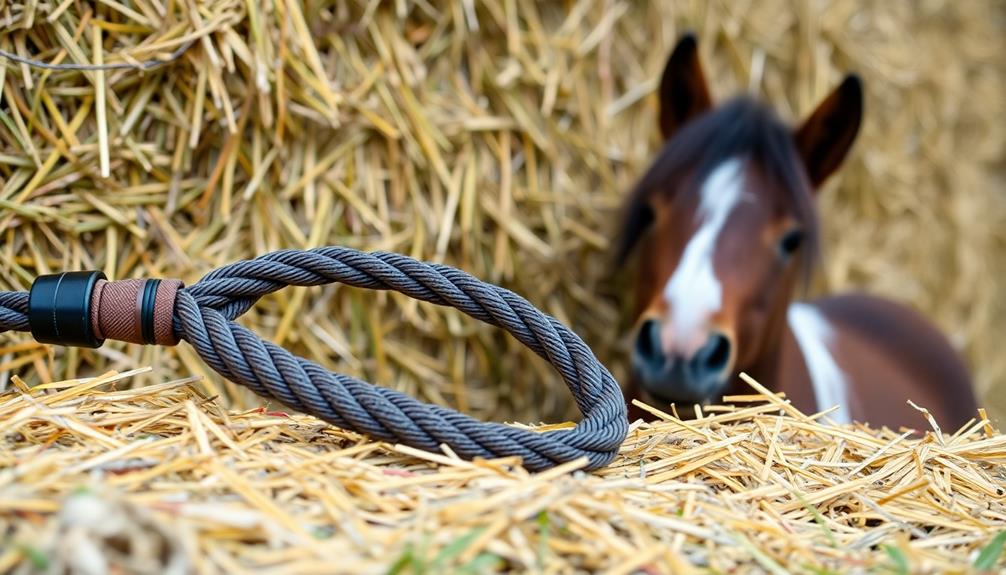
When it comes to choosing a driving whip for your miniature horse, user experiences reveal a wealth of insights that can enhance your driving journey.
Many drivers have shared their thoughts on how the right whip can greatly improve comfort and reduce pain during use.
Here's what you need to know:
- Comfort is key; MCR Ultra Lite whips are praised for their lightweight design.
- Floppy lashes are preferred for better reinsmanship and precise control.
- Custom modifications to existing whips often lead to improved handling.
- The right whip length matters; some find MCR whips too long for Class A Minis.
- Online communities are a treasure trove of solutions for whip-related challenges, like lash entanglement.
Key Purchasing Considerations
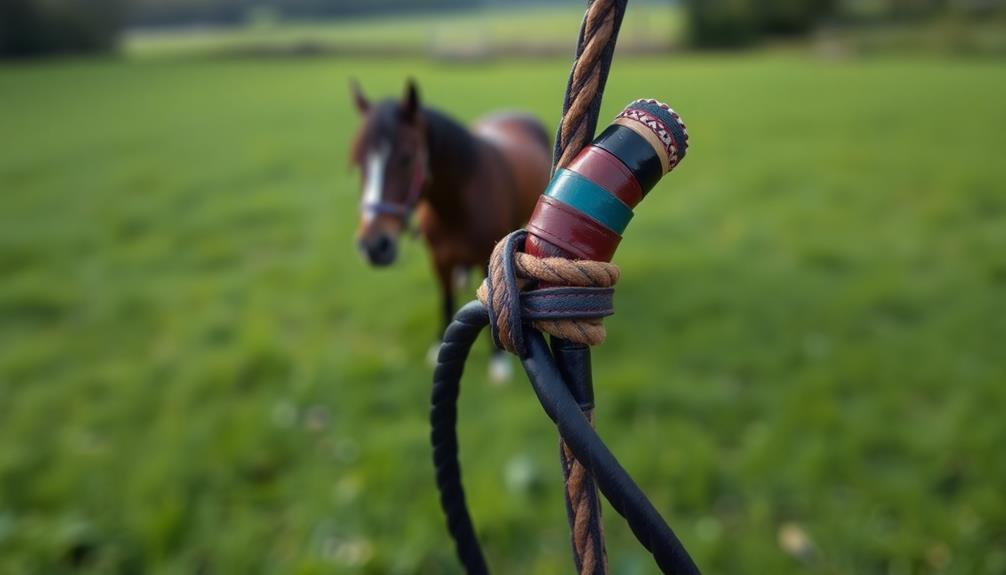
Choosing the right driving whip for your miniature horse involves several key purchasing considerations that can enhance both comfort and control.
First, consider the appropriate length; the whip shouldn't exceed your horse's shoulder height. This guarantees safety and effective communication while driving.
Next, opt for lightweight materials like e-glass or specialized nylon. These options reduce strain and improve control, especially if you have smaller hands or arthritis.
It's also vital to test different whip grips and diameters. A slim grip, around 1/2 inch, offers better comfort and control.
Balance and weight distribution are essential for effective handling. A well-balanced whip allows for easier maneuverability during driving, making your experience smoother.
Additionally, if you're ordering lash whips online, be mindful of potential shipping costs. Local pickup is often a smart choice, allowing you to verify the whip fits your needs before making a purchase.
Community Support and Resources

Community support and resources play an essential role in the world of miniature horse driving. Engaging with fellow drivers not only enhances your skills but also boosts your confidence when using tools like the lash whip.
You'll find that sharing experiences and learning from others can greatly improve your driving journey. Here are some key resources to evaluate:
- Online forums where you can ask questions and share tips on whip usage.
- Local driving clubs that offer hands-on training sessions and community events.
- ADS shows and CDEs, which provide opportunities to connect with experienced drivers.
- Free membership options that grant you access to valuable content and discussions.
- Mentorship programs, pairing new drivers with seasoned pros for guidance on whip handling.
These resources create a supportive environment for both beginners and seasoned drivers.
Whether you're troubleshooting lash entanglement or seeking advice on driving techniques, you'll find a community enthusiastic to help you succeed.
Customization Options for Whips

When it comes to customizing your driving whip, you can adjust the length and flexibility to match your unique driving style.
You might also consider different handle designs and grip materials for improved comfort and control.
Tailoring these features guarantees your whip not only fits your needs but enhances your overall driving experience.
Tailored Length and Flexibility
Customizing the length and flexibility of your miniature horse driving whip can greatly enhance your driving experience. Having the right whip tailored to your needs guarantees better communication with your mini, whether you're practicing dressage or maneuvering through an obstacle course.
When thinking about customization, consider these factors:
- Length: Standard whips are usually 48 inches tall with a 12-inch lash, but you can adjust them based on your height and driving style.
- Flexibility: A whip that offers the right amount of flexibility allows for more precise cues to your horse.
- Measurement: Measure from the saddle to where you want the lash to end for best functionality.
- Grip: Adding grip tape to the handle can enhance your comfort and control, making it easier to manage your whip.
- Balance: Brands like MCR offer options that guarantee your whip balances perfectly with your hand size and your horse's responsiveness.
Unique Handle Designs
Having the right whip is just the start; the handle design can make a significant difference in your driving experience. When you're looking for customization options, consider unique handle designs that enhance comfort and control.
Manufacturers like MCR provide customization that allows you to choose specific measurements, ensuring the whip fits your hand perfectly.
For those who prefer a more tailored approach, the HyperLite whip offers options not just in length but also in the handle design. You can select slimmer grip options, around 1/2 inch in diameter, which are ideal for smaller hands. This feature helps improve handling and reduces fatigue during longer drives.
Additionally, you can personalize your whip with different materials and finishes that match your aesthetic preferences while still maintaining functionality.
Whether you prioritize comfort, style, or both, unique handle designs allow you to create a whip that feels just right in your hands. Ultimately, the right handle design can transform your driving experience, making it more enjoyable and effective as you guide your miniature horse.
Grip Material Choices
Selecting the appropriate grip material for your miniature horse driving whip can greatly improve your overall experience. The grip you choose can influence comfort, control, and handling, so it's crucial to choose wisely.
Here are some popular grip material alternatives you might evaluate:
- Tackified leather: Offers enhanced comfort and superior control.
- Lightweight composites: Reduces whip weight for easier handling.
- Slim grips (1/2 inch diameter): Perfect for smaller hands, minimizing fatigue.
- Grip tape: Adds extra comfort and improves grip during driving.
- Customized sizes: Tailored to fit various hand sizes, ensuring a secure hold.
Different manufacturers, like Dobert and Ultralite, provide options that cater to your unique needs.
Users often report that the grip material greatly impacts the whip's balance and handling, making it crucial to assess your personal preferences.
Whether you prefer a sleek composite or the traditional feel of leather, the right grip will make all the difference in your driving experience.
Don't underestimate how a well-chosen grip can enhance your control and enjoyment while working with your mini!
Importance of Practice and Technique

How essential is practice when it comes to mastering the driving whip? It's vital! Regular practice not only enhances your familiarity with the whip but also boosts your control, allowing for greater precision in driving tasks. Over time, you'll develop muscle memory that makes handling the whip feel more intuitive, especially during competitions or training sessions.
| Benefits of Practice | Key Techniques |
|---|---|
| Enhances familiarity | Understand proper whip angles |
| Improves control | Keep lash tip below shoulder |
| Builds muscle memory | Focus on consistent use |
Mastering whip handling techniques can take a year or more, depending on your dedication and practice frequency. Consistent use of the whip reduces the likelihood of mishaps, such as getting it stuck while driving. Remember, the right technique is vital for both your safety and effectiveness. By practicing regularly, you'll not only become more comfortable but also guarantee that your driving experience with your miniature horse is enjoyable and successful. So grab that whip, and let's get practicing!
Recommended Driving Harnesses

When you're selecting a driving harness for your miniature horse, consider the material options available, as they can impact durability and comfort.
You'll also want to compare key features like adjustability and ease of use to find the best fit for your needs.
Let's explore some top recommended harnesses that cater to different budgets and preferences.
Harness Material Options
Selecting the right harness material for your miniature horse can greatly impact both performance and comfort. When you're choosing a harness, consider the various harness materials available that fit your driving needs.
Leather and nylon are the two primary options, each with its own benefits.
- Ozark Mini/Pony Leather Harness: Durable and classic, starting at $351.10.
- Tough1 Basic Nylon Driving Harness: Affordable and flexible, available for $144.76.
- Ozark Russet Leather Pleasure Harness: Offers a timeless look, priced at $467.50.
- Tough1 Deluxe Nylon Driving Harness: A great budget-friendly option, starting at $189.62.
- Tough1 Tracker Leather Mini Driving Harness: Perfect for specific driving needs, priced at $176.32.
When selecting your harness materials, think about your driving style and your mini's comfort.
A well-fitted harness should be lightweight yet sturdy, with adjustable features to guarantee it suits your horse perfectly.
Key Features Comparison
Choosing the right driving harness for your miniature horse involves understanding the key features that set each option apart.
The Ozark Mini/Pony Leather Harness is a premium choice, priced at $351.10 but currently discounted by 20%. Its durability and stylish design make it stand out, especially for regular use.
If you're on a budget, the Tough1 Basic Nylon Driving Harness starts at $144.76 with a 30% discount, making it an excellent entry-level choice for new drivers.
For those who prioritize elegance, the Ozark Russet Leather Pleasure Harness begins at $467.50 and offers exceptional craftsmanship, but it's a higher investment.
The Tough1 Tracker Leather Mini Driving Harness is versatile, starting at $176.32 with a 30% discount, suitable for both pleasure and competitive driving.
If you're looking for a balance of affordability and functionality, consider the Tough1 Deluxe Nylon Driving Harness, priced at $189.62 and also enjoying a 30% discount.
Each harness typically includes a lash for effective control, so think about your specific needs and budget when making your choice.
Investing wisely will enhance both your and your mini's driving experience.
Essential Driving Accessories
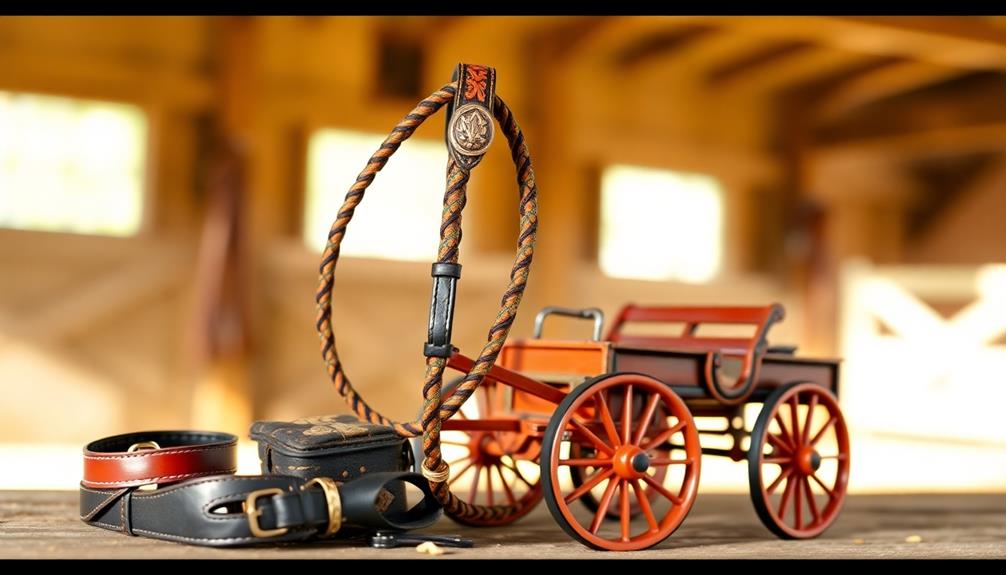
Essential driving accessories play a crucial role in guaranteeing a smooth and enjoyable experience for miniature horse enthusiasts.
When you're out there driving your mini, you want to have the right gear at your fingertips. Here's a list of essential items you'll want to reflect upon:
- Lightweight driving whips for effective communication and control
- Durable harnesses, like the Tough1 Basic Nylon Driving Harness, to safely attach your horse to the cart
- Padded harness bags from Kensington to protect and organize your driving gear
- Comfortable gloves to guarantee a firm grip while handling the reins
- Training DVDs, like the Ozark SIM Pony Primer series, for valuable guidance on driving techniques
Investing in quality driving whips and these accessories not only enhances your driving experience but also promotes safety and efficiency.
Whether you opt for the Tough1 Gaited Whip or the Deluxe Leather Handle Driving Whip, choosing the right whip tailored to your needs can make all the difference.
Equip yourself with these essentials, and you'll be well-prepared for a fantastic driving adventure with your miniature horse!
Discounts and Promotions Available
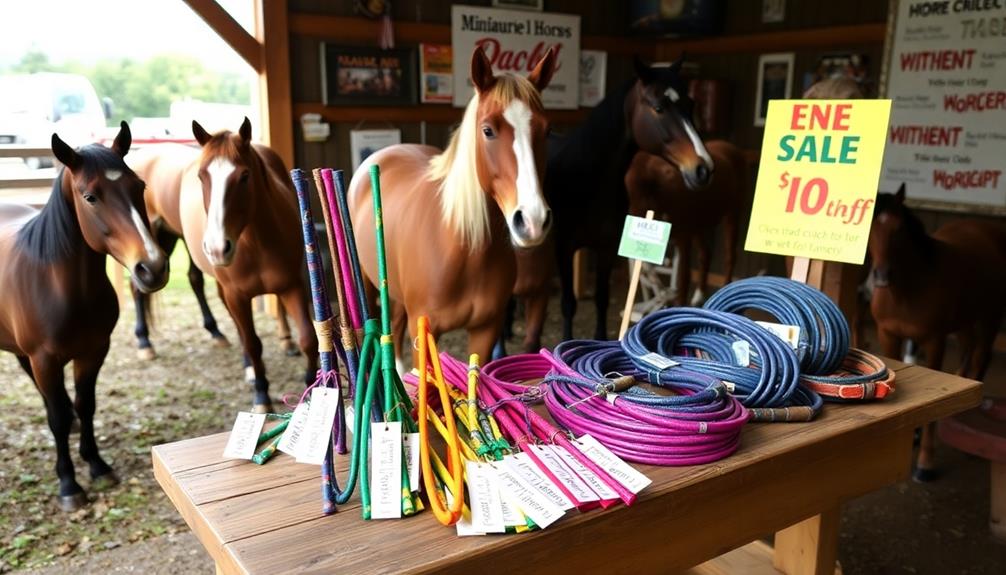
When gearing up for your next driving adventure, you'll appreciate the variety of discounts and promotions available for miniature horse driving gear. These offers can lead to significant savings, especially if you're looking to purchase multiple items. For instance, you can enjoy discounts of up to 30% off when you spend over $129, making it easier to get everything you need.
Here's a quick look at some current deals:
| Product | Discounted Price |
|---|---|
| Tough1 Mini Spotted Leather Show Harness | $186.82 |
| Miniature Horse Driving Whip | $XX.XX |
| Driving Accessories (various) | Sale price in cart |
| Seasonal Promotion Items | Varies |
Many sales and promotions are regularly refreshed, so it pays to check back often. You might find that certain sale prices are only visible in your shopping cart, which is a great reminder to review your selections. Signing up for email notifications can also keep you updated on the latest discounts and promotions available for your Miniature Horse. Don't miss out on these opportunities to save!
Frequently Asked Questions
What Is Needed for a Mini Horse?
To care for your mini horse, you'll need appropriate feeding, a safe shelter, proper grooming tools, regular veterinary check-ups, and suitable equipment for exercise and training. Regular social interaction is also essential for their well-being.
Do Mini Horses Need Horse Shoes?
Mini horses don't always need shoes, but if you're driving or engaging in high-impact activities, shoes might help with traction and wear. Regular hoof care is essential, so consult a farrier to assess your mini's needs.
How Do I Keep My Miniature Horse Fit?
Think of your miniature horse as a vibrant garden; to keep it flourishing, give it varied workouts like driving, lunging, and agility courses. Monitor its weight and guarantee it gets plenty of playtime for ideal health.
How Much Do You Have to Weigh to Ride a Mini Horse?
To ride a miniature horse, you shouldn't weigh more than 20% of its body weight. If your mini weighs 300 pounds, your weight should ideally stay under 60 pounds to guarantee the horse's comfort and safety.
Conclusion
In the world of miniature horse driving, the right whip is like a conductor's baton, guiding your little partner through a symphony of movement. With the right gear, practice, and technique, you'll both dance harmoniously across the arena. Remember, it's not just about the equipment; it's about the bond you build together. So, saddle up, embrace the journey, and let your miniature friend shine bright in the spotlight of your shared adventures!
